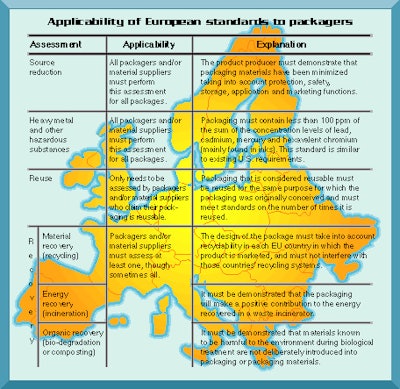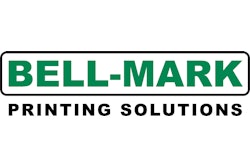Many products as they're currently packaged could be banned in Europe due to new European Union (EU) regulations. The EU is finalizing so-called "essential requirements" that will establish standards for how packaging must meet environmental demands such as source reduction, reuse, recycling and the use of heavy metals. These standards are expected to be finalized sometime during the year 2000. (Separately, the U.K. and France have already passed their own standards. These are not expected to be enforced strongly until the EU requirements have been finalized.) Under the new requirements, packaged products could be banned if: (a) they interfere with the recycling program of the country in which the product is sold, (b) their packaging is not easily recovered, or (c) they could be packaged with less material, without interfering with performance. Examples of packaging that could be banned include blue glass, polyvinyl chloride shrink sleeves, pigmented high-density polyethylene milk containers, excessively large boxes (of any material) for software or CDs, multilayer laminated paperboard materials and many more. Manufacturers that sell packaged products in Europe will be required to maintain documentation showing that the products meet these "essential requirements." Hundreds of existing packages currently in the European marketplace may require modification in order to comply. The envelope, please The essential requirements include six individual standards for packaging and one standard that links all the elements together: 1. Source reduction 2. Limiting heavy metals and other hazardous substances 3. Material recovery (recycling) 4. Energy recovery (through incineration) 5. Organic recovery (composting and biodegradation) 6. Reusability The standard linking these elements together is titled "Packaging and the environment," and it specifies how to comply with the six individual standards as a whole. The specific details for these standards are contained in seven separate publications, each roughly 20 pages, that include checklists, forms and guidelines. They can be purchased in the U.S. from Custom Standards Services (Ann Arbor, MI) at 800/699-9277. More information can also be obtained directly from the European Committee for Standardization (or CEN, as it's known by the French acronym) at www.cenorm.be. All packages will be required to meet the source reduction and heavy metals standards. Packagers who claim their packaging is reusable must then meet the reusability standard. Finally, packagers will be required to meet at least one (and sometimes all) of the recovery standards (material, energy and/or organic). That is, manufacturers will be required to demonstrate that their packaging is recoverable in a given country's material recycling system, produces energy if incinerated, or is compostable or biodegradable. Manufacturers will also be required to demonstrate that their packaging does not interfere with existing recovery programs. For example, blue glass could contaminate a specific country's glass recycling program or a PVC shrink label could contaminate a country's polyethylene terephthalate recovery program. These materials can be used only if the packager can justify (to government officials upon demand) that their use is critical to the function of the package. Documentation burden Under the proposed draft, product manufacturers must assess their own packaging for compliance and maintain in-house records that document compliance with the standards. Such assessment documentation must be available for government review upon demand. Each assessment that a manufacturer prepares must address all packaging components for each packaging "system." A system is defined as all primary, secondary and transport packaging associated with a given product. For example, for source reduction, the company must determine which functions of the package (protection, safety, storage, application and marketing) are critical and how the packaging can be further reduced without negative impact. For recyclability, a manufacturer would be required to determine which facilities are needed to recycle each packaging component and if those recycling facilities exist in the country in which the package is sold. For example, if Spain lacks the paper recycling facilities to handle laminated paperboard, a packager cannot select recycling as its recovery option. The assessments must be retained for at least two years (four in the U.K.) after a package is removed from the market. Upon request, the responsible party (in most cases, the manufacturer) will have to produce documentation showing that the packaging met the requirements. U.K., France go it alone France passed its own "essential requirements" that went into effect on October 20, 1998, and are similar to, but not as detailed as, the European standards. The French standard requires that the supplier of the packaging (if from the EU) or the manufacturer (if not from the EU) have a written declaration on file stating that all packaging related to a product conforms to the requirements. Upon request by enforcement authorities, the responsible party will have 15 days to produce the documentation, which must show that the packaging meets the French requirements. Companies that meet the European standards, once they are passed in 2000, will be automatically in compliance with the French requirements. Products that were packaged or filled before 1995 are exempt from the French requirements. Packaging materials that were manufactured in accordance with the rules in force before January 1, 1995, shall be permitted until January 1, 2000. After that date, such packs will have to comply with the new standards. Last August, the U.K. published guidance notes on implementing its regulations. Enforcement of the U.K. regulations were scheduled to begin January 1, 1999. Compliance can be demonstrated by supplying sufficient technical documentation to an enforcement officer, for a period of up to four years from the date the packaging is removed from the market. The U.K. regulations suggest the use of the draft European standards at this time. As in France, products that meet the CEN standards will also meet the U.K. standards. Modifying the design process U.S. packagers and packaging suppliers should incorporate this self-assessment into the packaging design process itself. For example, an assessment should show that the packaging designer reviewed the environmental impact of the materials selected during the design process. Package designers who are not familiar with these requirements will need to become familiar with them. Sometimes, simplified checklists can be prepared to help guide material selection decisions to prevent the wrong materials from being selected for a given country. Regardless, product manufacturers and packaging suppliers must establish a paper trail showing how each standard was incorporated into their packaging design protocol. Both should establish a packaging database that should include all the data necessary to prepare country eco-fee reports (material types and weights), plus sufficient information regarding material types to determine how the material can be recovered. Of critical importance, a producer must establish a certification system to determine and track (from materials and/or packaging suppliers) the recyclability, energy value, biodegradability, recycled content and heavy metals concentrations of the packaging materials used. The good news is that elements of this process could already be part of a company's ISO 9000 or 14000 program. (These are standards, promulgated by the Intl. Standards Organization, that manufacturers follow in order to be certified as operating at a certain, documented level of quality.) A six-month comment period began November 19, 1998, to review the European essential requirements. Companies selling products in Europe should take advantage of this opportunity to comment. Comments can be submitted to any of the CEN National Standards Bodies such as British Standards Institution (BSI), but not, ironically, to CEN itself. (Editor's note: In a special arrangement for Packaging World's readers, Brian Such, Project Manager, Packaging and the Environment at BSI, has indicated he will forward comments he receives via e-mail at [email protected] to the CEN Technical Committee.) The present draft is generally favored by industry, but there is a strong movement by government officials in some member states (mainly Germany) to make these requirements more demanding by removing the self-assessment process and by establishing stricter guidelines. (Victor Bell will be speaking on this topic at Southpack in Atlanta, May 18, 1999.) Victor Bell, CPP, is president of Environmental Packaging Intl., which specializes in global environmental packaging and product stewardship requirements. He can be reached at 401/423 2225 or [email protected].
































